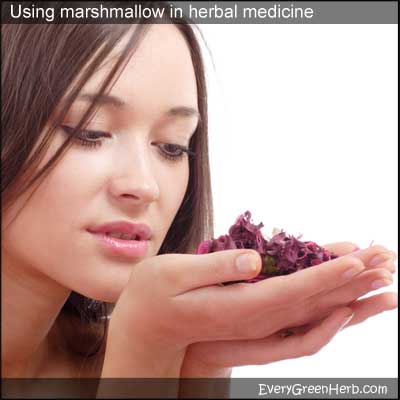Marshmallow in herbal medicine and home remedies

Marshmallow (Althaea officinalis) contains lots of mucilage which soothes and heals. Take marshmallow tea for digestion problems and urinary tract infections.
Marshmallow mucilage coats, cools, and moisturizes inflamed tissues. Drink three or four cups a day of weak marshmallow root tea for best results.
Marshmallow helps heal and protect the body.
Marshmallow is a very useful medicinal herb. Marshmallow flowers, leaves, and roots are used in the treatment of everything from coughs to ulcers. It is especially good for digestive and colon problems.
Marshmallow is a good remedy for inflamed mucus membranes, peptic ulcers, gastritis, urinary problems, bladder infections, sore throats, colds, headaches, muscle pain, wheezing, asthma, burns, boils, skin ulcerations, fluid retention, diarrhea, mouth sores, varicose veins, and chapped skin.

Marshmallow also helps relieve dry coughs.
Marshmallow's complex carbohydrate molecules benefit the respiratory system. The herb is used in many lung preparations and cough syrups to relieve dry, hacking coughs, whooping coughs, and laryngitis.
It also helps to loosen phlegm, and helps make coughing less painful and more productive.

Marshmallow helps relieve pain.
Marshmallow is also good for relieving pain. The plant contains salicylic acid (the natural forerunner of synthetic aspirin), and is recommended for treating muscle pain and tension headaches.
Use marshmallow poultices for skin problems.
Marshmallow roots may be boiled, mashed, and made into an ointment or poultice. Apply to burns, boils, skin ulcers, chapped skin, and other rashes for a soothing remedy that helps speed healing.
Used externally, marshmallow root may also be used in an ointment to soften and soothe skin and dry hands. The mucilage protects damaged, irritated skin so it can heal more quickly.
Read more about making your own homemade ointments and poultices.
Science and marshmallow
Studies show that marshmallow root extract contains powerful anti-inflammatory and anti-oxidative properties. Applications of the extract work by forming a protective film over inflamed tissue, which reduces irritation and allows faster healing. Marshmallow is also proven effective against dry cough caused by irritation.
Studies are currently underway to see if marshmallow extract is a suitable treatment for disease in fish. It appears that marshmallow can provide considerable resistance to several types of bacterial infection in the carp population.
Marshmallow has a sweet history.
In centuries past, marshmallow root was made into a royal dessert. The tasty treat was called “Pate de Guimauve” and included a foaming mix of sugar, egg whites, and ground marshmallow root. The resulting spongy concoction was greatly enjoyed by the French court.
Modern-day store-bought marshmallows are mostly air, gelatin, and sugar.
In modern times, Kraft Foods developed the “JetPuff” technique where sticky gelatin was combined with sugar, concentrated to almost the caramel stage, and whipped to incorporate large amounts of air bubbles.
Unfortunately, today’s candy type “Marshmallow” doesn’t contain even a pinch of the actual herb.
Marshmallow flowers are sweet and the leaves are delicious.
Fresh marshmallow flowers are sweet and tasty. Pick and eat them right from the garden or meadow.
Marshmallow leaves make one of the best green vegetables of any wild plant. (They become tender very quickly so don’t overcook.) The nutritious leaves also make good additions to soups and stews.

Marshmallow plants will grow in swampy marshes.
Marshmallow is related to the popular flower known as hollyhock.
The marshmallow plant loves water and will grow in soggy soil including swampy marshes.
The perennial plants bear hibiscus-like pink, white, or purple blossoms and may grow to a height of six feet. They look striking in the back of a flower border.
Originally from Europe, marshmallows now grow wild in parts of the western United States. Marshmallows are sometimes grown in the home garden. Plant seeds in a damp, sunny place for best results.
* Internal use of marshmallow can slow the absorption rate of other medicines. Otherwise, the herb is considered very safe for external and internal use.
Always consult with a healthcare professional before using any herbal remedy especially when pregnant, nursing, or taking other medications.
Sources:
https://www.ncbi.nlm.nih.gov/pmc/articles/PMC7090173/
https://www.ncbi.nlm.nih.gov/pmc/articles/PMC5524553/
Blessings to you and yours!
Thanks so much for reading my blog. Jan.

*Note - the information on this website has not been evaluated by the Food and Drug Administration.
© 2005-2024 website design and content by Janice Boling